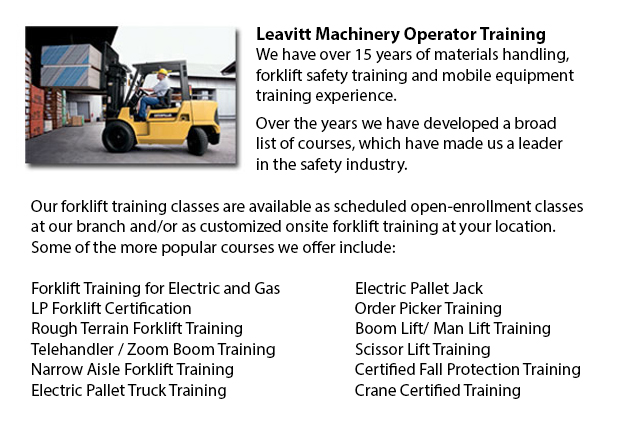
Kitchener Forklift Training Program - The forklift is a common powered industrial vehicle that is in wide use nowadays. They are sometimes known as lift trucks, jitneys or hi los. A departments store will make use of the forklift to load and unload merchandise, whereas warehouses would utilize them to be able to stack products and materials. And grocery stores use small models to drop stock in the aisles. Whether transporting lumber at a sawmill or loading material at a construction site, forklift operators should be trained correctly and licensed. The main concern should be on worker and pedestrian safety. This lift truck training course teaches the health and safety regulations governing forklifts to be able to ensure their safe and efficient utilization.
Forklift Training Program Safety Guidelines:
Forklift training courses are meant to ensure that the operator can safely control the forklift throughout lifting, tilting and traveling. Only qualified operators must drive a forklift.
When the forklift is in operation; head, arms, hands, legs and feet must be kept in the forklift. Lift truck forks must be kept low to the ground while being slightly tilted back. Observe posted traffic signs. Honk the horn and lessen speed when taking a corner. If the driver's vision is blocked by the load, slowly drive backwards. Pre-check the ground for possible hazards, such as wet or oily spots, objects, holes, rough patches, people and vehicles. Avoid sudden stops.
If pedestrians pass across the vehicle or moves into a blind spot, the forklift should be stopped, the load lowered, waiting until the path is clear. If a load is being transported on an incline, the forks must be pointed uphill with a load and downhill without a load. The forklift must only be turned around if on level ground.
Safety tips when steering - If traveling at good speeds, never turn the steering wheel sharply. Support the load making use of the front wheels and turn making use of the back wheels. A truck which is overloaded would be difficult to steer. Adhere to load restrictions. Do not add a counterweight in order to improve steering.
Safety tips while loading - The forklift's recommended load capacities should be followed; the information can be found on the data plate. Always ensure that the load is placed according to the recommended load centre. The forklift will remain stable as long as the load is kept near the front wheels.
Before inserting the forks into the pallet, the mast of the forklift should be in an upright position. Level the forks before inserting them.
-
Kitchener Forklift Training Schools
Kitchener Forklift Training Schools - The Advantages Of Taking One Of Our Forklift Training Schools Are you searching for work as a driver of a forklift? Our regulatory-compliant mobile equipment operator training offers instruction in types of fo... More -
Kitchener Overhead Crane Operator Training
Kitchener Overhead Crane Operator Training - Our overhead crane operator training course is designed to teach employees the basics of overhead crane/sling operation and pre-shift checks. Courses are taught by our expert trainers and consultants. Well... More -
Kitchener Crane Training School
Kitchener Crane Training School - The crane training school offers industry-relevant programs. Courses provide trainees with learning outcomes which match present industry demands. Our small class sizes combine hands-on experience and theory. Our qua... More -
Kitchener Skid Steer Ticket
Kitchener Skid Steer Ticket - The lift arms on the skid-steer loader are located at the side of the driver along with pivots behind the driver's shoulders. These features makes the skid-steer loader different as opposed to the conventional front load... More -
Kitchener Manlift Operator Certification
Kitchener Manlift Operator Certification - Our scissor platform and aerial lift training and certification empowers participants with a knowledge and general understanding of the efficient and safe use of "Power Operated Mobile Work Platforms," under... More -
Kitchener Crane Safety Training
Kitchener Crane Safety Training - Companies and crane operators have to be aware of the problems related to crane safety. Legislation provides rules for the safe operation, inspection and maintenance of lifting machines all around North America. Cran... More -
Kitchener Forklift Training Programs
Kitchener Forklift Training Programs - Are you searching for work as a forklift driver? Our regulatory-compliant mobile equipment operator training offers instruction in kinds of forklifts, pre-shift check, fuel kinds and dealing with fuels, and safe... More -
Telehandler Training in Kitchener
Telescopic handlers often known as telehandlers for short, are an extremely popular piece of heavy construction machinery. They are commonly used in the construction and agricultural industries. These equipments have extreme reaching ability and can... More

Forklift Certification Kitchener
TOLL FREE: 1-888-254-6157
Kitchener, Ontario
forkliftcertificationkitchener.com
Email Us
About Us


